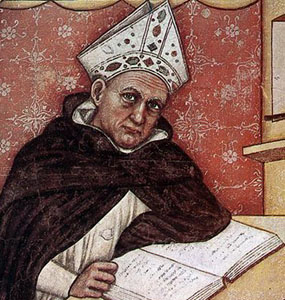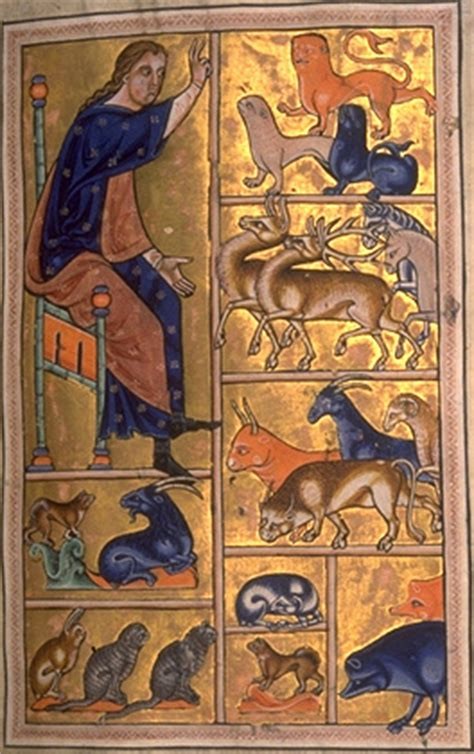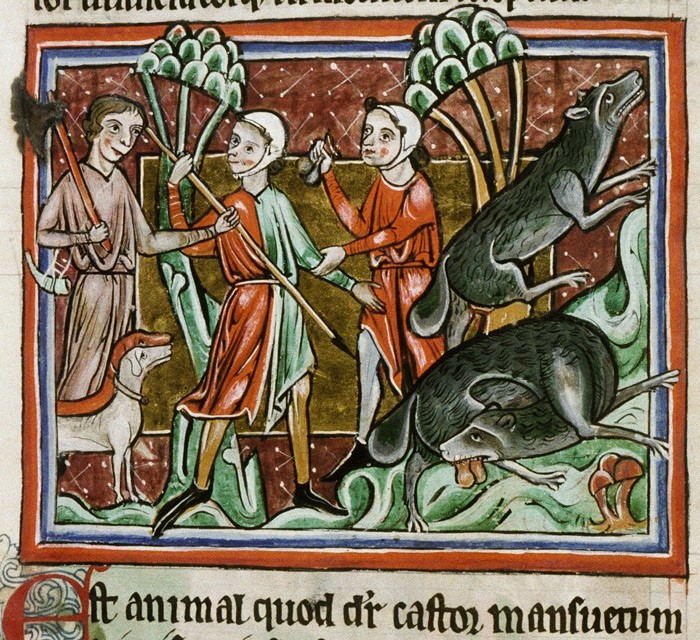(Toim. huom.: suomenkielisen käännöksen tästä esseestä löydät klikkaamalla tästä!)
Philip Line
As I suspect many researchers in medieval history and culture have done, I sometimes ponder, if it were possible to go back in time, which famous (or infamous) medieval person I would like to meet. In my case it would be Albertus Magnus (Albert the Great, c. 1195-1280). So far, however, my closest encounter with him has been through his works on natural philosophy, which I have read as part of my ongoing research into medieval (human) attitudes to (nonhuman) animals.

Unlike his more famous contemporary Thomas Aquinas, Albert is not well-known outside Germany, although he certainly was in late medieval Europe. More recent opinions on his abilities have varied. According to James Hannam’s recent popular book on medieval science, his main claim to fame is that he was able to spot the true talent of Thomas when the latter was his pupil in Paris. One of the sixteenth-century commentators on Aristotle’s works on animals, Augustino Nifo, was scathing about Albert’s opinions, rarely mentioning his predecessor’s opinions about Aristotle’s philosophy without comments like “Albert is babbling again.” However, whatever Nifo may have thought, in his era Albert’s works were still regarded as authoritative. Albert was known in his own time as doctor universalis, as he wrote on virtually every aspect of philosophy and theology and set out to write a commentary on all the known works of Aristotle, most of which he completed before he died at a considerable age.
Albert’s natural philosophy
Several modern scholars have pointed out that Albert got a large amount of the information in his De Animalibus (on Animals) from the Liber de natura rerum of his contemporary and fellow Dominican Thomas of Cantimpre, but unlike Thomas, Albert did not mention his sources. This is true, but all familiar with medieval scholarly methods know that there was no crime in borrowing the work of others without acknowledgement in the Middle Ages, and even those like Thomas who did enumerate their sources rarely specified clearly which information came from whom. Medieval scientia was not modern science, which is why we refer to Albert and others like him as natural philosophers rather than natural scientists. Medieval scholars drew heavily on the classical works that were then available to them and the works of the Church Fathers. As St Paul had said, “Our knowledge [of God and his purpose] is imperfect”, and it was believed that this knowledge could be acquired solely through use of logos (language and rationality), a gift of God to humans. No natural philosopher had sought empirical evidence since Aristotle, and we have no record of his methods. The ultimate reference for all medieval scholars was of course the Bible, which stated that God had made “man” in his own image and given him dominion over the animals: indeed, he had appointed the first man to name them. Adam naming the animals was one of the most popular subjects of medieval iconography.

As explicators of God’s purpose and methods the works of the Church Fathers, especially Augustine of Hippo, had huge authority. Otherwise the sources of information about the nature and types of animals were classical scholars such as Pliny, Solinus and Aelian, and the sixth-seventh-century bishop Isidore of Seville, himself a compiler of classical knowledge. When medieval philosophers observed the world their primary interest was the place of humans in the cosmos. Since creation was perceived as the work of God, its nature was an indicator of his intentions. Animals were a part of this creation, but the primary concern of theologians and philosophers was the supposed ability of humans to comprehend something of God and his works, their transcendent nature and their capacity to exceed the confines of the physical natural world.
Many philosophers felt that they had to understand the animal part of human nature to understand how the human could be what the animal was not. However, few were interested in animals as such, and Augustine had warned against seeking knowledge for its own sake. Albert the Great was an exception in that he did show a genuine interest in animals and their ways and he did sometimes make observations or carry out experiments to test his ideas or the truth of inherited information. Many of his methods would not suffice nowadays, for instance his use of spiders as substitutes for salamanders to test whether the newts were impervious to fire because no salamanders could be found. (In Finnish salamanteri refers solely to the mythical animal, but in English it is also a real animal, the newt pyrstösammakko.) Similarly, we would often not accept Albert’s use of analogy or polarity (opposition); in De mineralibus he uses the analogy of animal reproduction to explain the generation of some minerals, albeit denying that the mineral’s qualities (virtus) derive from any seed. Humans inevitably use allegory as we can only relate what we encounter to things already familiar to us, but analogies have to be used with care in modern science. Albert was no animist, but like other medieval natural philosophers, he used analogy in what we might consider an unscientific manner because all naturally occurring objects and beings conformed to a principle that natural forces operated in a consistent way, all motivated by the same underlying providence of God. God is not in stones, but they may have some special power imbued by him. Albert saw nature as universal, inclusive of God and the eternal, the celestial bodies, the earthly mobile bodies and finally stones, minerals, and earthly bodies that possessed a soul, namely animals and plants.
Having mentioned several dubious aspects of Albert’s work, there was much that advanced medieval natural philosophy. In addition, Albert sometimes recognised problems that still confront us today, such as classification of animals according to a human-devised system that is unrelated to the animal’s characteristics, which inevitably influences our conception of that animal’s place in nature. Mentioning this, Albert reluctantly adopted the current fashion that had become common in medical works and is familiar to us today, alphabetical order, a system that is convenient for finding references in books but not related to any properties of the subjects, only to the first letter of their name. Although in the Middle Ages the names of animals were thought to reflect their nature because they were named soon after the creation, the first letter alone was not significant. Albert also dismissed a number of the beliefs about animals that had become established in bestiaries and encyclopaedias – that the beaver gnawed off its own testicles and threw them to hunters to save its own life, that geese were born from barnacles, and so on.

Aristotle becomes Christian
The groundwork for the scientific advances of the thirteenth century had been laid in the previous century with the rise of scholasticism and the advent of the universities, but Albert and Thomas Aquinas did more than any others to bring Aristotle’s science into line with Christianity when it was under suspicion, not just because Aristotle was a pagan Greek, but because much of his work that had been lost to Latin Europe in the early Middle Ages was recovered via Arabic translations and commentaries on it. The new material included virtually all of Aristotle’s work on zoology. For Albert, Aristotle’s metaphysics as study of the first principle was equated with theology as the study of God. Aristotle’s science has long since been abandoned, but in the thirteenth century it was a huge advance on what had gone before.
Because of the adoption of Aristotle’s classifications, the gap between humans and other animals, between different groups of animals and even between animals and plants was narrowed: as Aristotle had written, “Nature proceeds from the inanimate to the animals by such small steps that, because of the continuity we fail to see to which side the boundary and the middle between them belongs.” (Historia animalium VII: 588b1.) The Persian polymath Avicenna (c. 980-1037 CE) had further refined some of Aristotle’s arguments. Making use of both Aristotle and Avicenna, Albert, for instance, noted that zoophytes were not far removed from plants. They had movement, but only by dilation or constriction and they could not move from one place to another. Thus movement (whether in loco or ad loco) became a defining feature of animals. The defining difference between humans and other animals, however, was the former’s ability to rationalise and possession of a rational soul.
Augustine of Hippo, although he had drawn on the work of many philosophers before him, both pagan and Christian, had established beyond dispute (to the medieval mind) that of the living beings on Earth humans alone had the ability to rationalise and that only they had free will. Medieval thinkers argued that all the physical advantages that humans had, such as hands and upright stance on two legs, were given to enable use of rationality. This ability to rationalise meant that they alone could know God, and this was what enabled the human soul to survive the death of the physical body. Whatever secular folk thought in the Middle Ages, scholars accepted that animals had souls, but they were tied to the body and most agreed that they did not survive its destruction.
Aristotle had argued that living entities that were capable of growth, nutrition, reproduction and certain other activities but did not sense and respond to their environment had vegetative or nutritive souls. Beings that were alive and could sense their environment and respond to it but lacked rationality had sensitive souls also. Those that possessed not only life and sentience but the capacity for rational thought and free will had rational or intellective souls. Only one species had a soul in its fully developed form with all three parts: human beings. Because they had intellective souls humans could form universals, that is, they could extrapolate beyond an observation of something to form a general understanding of its nature, which again, in the interpretation of medieval theologians, was essential to know God. (Medieval thought on universals, and indeed whether they were a reality or not, is not a research subject for the faint-hearted, so I will not attempt to explain it further here!)
Animals on the edge of rationality?
How, then, did late medieval natural philosophers explain apparent making of choices or planning for the future by animals? Most adopted the theory of Avicenna, that animals had a sort of instinct that enabled them to estimate immediate danger or which food was edible, estimativa, but that still left many problems: for example, birds built nests in preparation for the birth of their young, or ants for the coming summer. Albert allowed animals what he called “a shadow of reason”. Later thinkers would come up with various explanations, but like Albert, they had to conform to the theological imperative that only humans had true reason and a rational soul.
The time when Aristotle’s theories would be abandoned altogether lay two centuries in the future, but they were coming under increasing strain. Jean Buridan (c. 1300-1358/61), for example, even pointed out that humans have no way of knowing exactly what is occurring in animal minds when they make a decision. If the “science” of natural philosophers like Albert looks more like pseudo-science to us and medieval methods of classification on the basis of habitat or method of locomotion seem antiquated, we would do well to remember that the natural philosophy of Albert and others like him was huge advance on what had come before in the Middle Ages in that they questioned why things were as they were. We may also ask in what way our attitudes to animals are an improvement on medieval attitudes. Despite our knowledge of evolution, humans generally still regard themselves as the crown of creation, and our own system of taxonomy, based purely on biology, now obscures all other classifications almost entirely and takes no account of the moral worth of nonhuman animals.
Philip Line has been writing a book on medieval attitudes to animals for some years, and is now conducting research alongside several other researchers as part of the project ’Ihmisen naapurit ja kumppanit: Muunlajisten eläinten luonne ja asema antiikin ja keskiajan filosofiassa, kirjallisuudessa ja kulttuuriperinteessä’ (‘Neighbours and companions of humans: the nature and place of other animals in ancient and medieval philosophy, literature and cultural tradition’), funded by the Kone Foundation.
Selected bibliography
Sources:
- Magnus Albertus, B. Alberti Magni, Batisbonensis Episcopi, Ordinis Praedicatorum, Opera Omnia: Animalium Lib. XXVI.; Pars Altera, XIII-XXVI (London: Forgotten Books, 2017)
- Albert the Great, Book of Minerals, tr. Dorothy Wyckoff (Oxford: Oxford University Press, 1967)
- Albert the Great, Man and the Beasts: De Animalibus (Books 22-26), Medieval and Renaissance Texts and Studies 47 (New York: Center for Medieval and Early Renaissance Studies, 1987)
- Albert the Great, On Animals: A Medieval Summa Zoologica, tr, and ed. K.F. Kitchell, Jr. and I.M. Resnick, 2 vols (Baltimore: John Hopkins University Press, 1999)
- Albert the Great, On the Causes of the Properties of the Elements, tr. Irven M. Resnick (Milwaukee: Marquette University Press, 2010)
- Albert the Great, Questions concerning Aristotle’s On Animals, tr. Irven M. Resnick and Kenneth F. Kitchell, Jr. The Fathers of the Church: Medieval Continuation, 9 (Washington, D.C.: CUA Press, 2008).
Literature:
- De Leemans, Pieter, and Matthew Klemm, “Animals and Anthropology in Medieval Philosophy”, in Brigitte Resl, ed., A Cultural History of Animals in the Medieval Age, A Cultural History of Animals, 2 (Oxford: Berg, 2007), pp. 153-77
- Honnefelder, Ludger, ed., Albertus Magnus and the Beginnings of the Medieval Reception of Aristotle in the Latin West: From Richardus Rufus to Franciscus de Mayronis (Münster: Aschendorff, 2005)
- Oelze, Anselm, Animal Rationality: Late Medieval Theories 1250-1350 (Leiden: Brill, 2018)
- Resnick, Irven M., ed., A Companion to Albert the Great (Leiden: Brill, 2013)
- [Not for the faint-hearted:] Spade, Paul V., ed. and introd., Five Texts on the Mediaeval Problem of Universals: Porphyry, Boethius, Abelard, Duns Scotus, Ockham (Indianapolis: Hackett Publishing Co., 1994)
- Hannam, James, God’s Philosophers: How the Medieval World Laid the Foundations of Modern Science (London: Icon Books, 2010)
